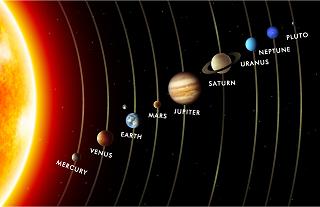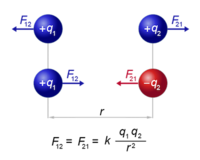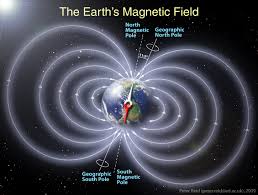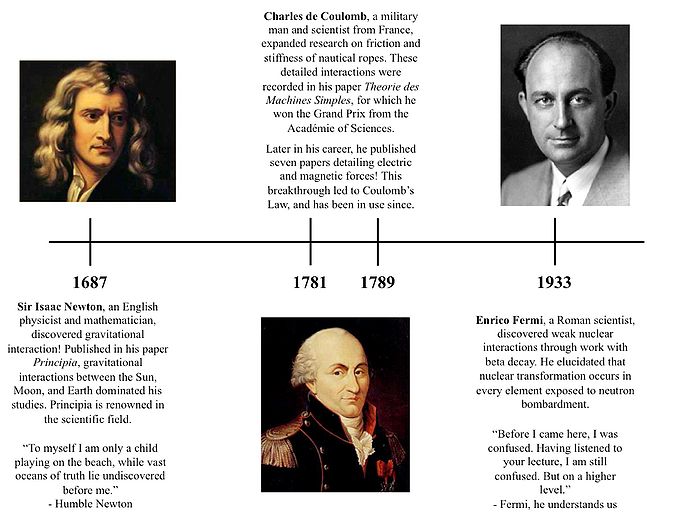Types of Interactions and How to Detect Them: Difference between revisions
Jclendenin3 (talk | contribs) |
Jclendenin3 (talk | contribs) |
||
| Line 79: | Line 79: | ||
A system interacts with gravity constantly, and not just Earth's gravitational interaction! The gravitational interaction of the Moon on the Earth controls the ocean tides. The Earth's gravitational interaction keeps the Moon bounded to its orbit. The Sun's gravitational interaction with all of the planets causes the planets to maintain an elliptical orbit around it. To determine the gravitational interaction between a system and gravity, we use the equation <math>{F_{grav}}={{m}}*{{g}}</math> , where '''m''' is the mass of the system and '''g''' is the gravitational constant. | A system interacts with gravity constantly, and not just Earth's gravitational interaction! The gravitational interaction of the Moon on the Earth controls the ocean tides. The Earth's gravitational interaction keeps the Moon bounded to its orbit. The Sun's gravitational interaction with all of the planets causes the planets to maintain an elliptical orbit around it. To determine the gravitational interaction between a system and gravity, we use the equation <math>{F_{grav}}={{m}}*{{g}}</math> , where '''m''' is the mass of the system and '''g''' is the gravitational constant. | ||
[[File:ElectricClendenin.png|thumb|200px|Figure | [[File:ElectricClendenin.png|thumb|200px|Figure 2.2 Electric Interaction between Charged Particles ("Electric force." Google, ''Google Images''. 16 April 2016.)]] | ||
===Electrical=== | ===Electrical=== | ||
Revision as of 14:52, 16 April 2016
Claimed by Julia Clendenin (15 April 2016)
This wiki will define interactions and examine indicators that reveal an interaction is taking or has taken place. It will also overview different types of interactions commonly encountered in physics.
Interactions
Simply, interactions are the casual relationship between an object and either another object or force that alters the behavior of the original object. A force is an energy that results in an action by some object, and is often calculated as mass times acceleration. Alternatively, interactions can be described as changes to the system as a result of the surroundings (external forces) or interworking of the system (internal forces). It is important to note that object and system are interchangeable, although system is the physics term more appropriately used. The system is the point of focus and is interacted upon or within itself. The surroundings refer to any outside forces that interact with the system.
Depending on the type of force, different equations are used to calculate the interactions within a system. Generally, force can be described as [math]\displaystyle{ \vec{F}={{m}}*{\vec{a}} }[/math], where m is the mass of the system in kilograms (kg) and a is the acceleration of the system.
Detecting Interactions
Since interactions alter the behavior of the system, there are several indicators that express any deviation: change in velocity, change in direction of motion, change in energy, uniform motion.
Change in Velocity
Suppose an object is at rest, or its velocity is equal to zero. Just from this simple statement, we can infer that at least two interactions have occurred: 1) an interaction is holding it in place, or preventing it from moving, 2) two interactions are oppositely acting upon the object, thus canceling each other out. Let's break down each one for clarity:
1) An interaction is holding it in place, or preventing it from moving.
Look at your desk. You probably have a calculator, a GT Infinite Harmony concert ticket, and pens sitting idly before you. Why aren't they moving? This lack of movement indicates some interaction occurring with each object. One such interaction is a gravitational interaction. As gravity pulls downward on your calculator, it stays on your desk instead of flying upwards (if only gravity didn't interact on our GPAs!). These objects exhibit an interaction because they are not moving where otherwise they could be. Another potential interaction is friction. While you'll delve deeper into friction and its intricacies later, for now, friction keeps objects from slipping (or moving). Look at your coffee mug on its coaster. It isn't sliding off the coaster because friction is keeping it in place.
2) Two interactions are oppositely acting upon the object, thus canceling each other out.
The interaction from the left plus the interaction on the right equate to zero, resulting in no movement from the object locked in the middle. When you moved out of your freshman dorm and pushed a box on the floor, your mischievous friend decided to push from the other side. With both of you pushing with equal force, the box did not move. In physics terminology, the net force on the x axis equals zero.
Change in velocity also includes decreasing and increasing velocities. Let's look at an example:
Suppose the object moves in the positive x direction, and then comes to rest. Which of the following could be the cause for the object's change in velocity?
a) an interaction in the +x direction is reduced
b) an interaction in the -x direction is reduced
c) an interaction in the -x direction is increased
d) an interaction in +y direction is applied
e) an interaction in the -y is applied
f) an interaction in the +z direction is applied
Let's dissect each option.
If an interaction from the +x direction is reduced, the object can continue to move at a constant velocity; just because the original interaction changes does not indicate that the system will cease to act. Thus, choice a) is incorrect. An interaction from the -x direction does influence the velocity of the system as it is acting in the opposite direction of the system's initial velocity. However, if the -x interaction is reduced, the force preventing the object from moving is lightened and the velocity reaches a constant; it does not necessarily stop, and choice b) is incorrect. If the interaction in the -x direction is emphasized, then the object's velocity will slow and then stop as the interaction increases to a point that overcomes the initial velocity of the object; answer c) is correct. For choices d), e), and f), since the object is moving in the x direction, the y interactions do not directly influence the x-direction velocity, thus all three are incorrect.
Change in Direction of Motion
Suppose you throw a paper airplane horizontally off Clough rooftop. Unfortunately, you're not a skilled aerospace engineer and the plane dives straight into Tech Brown after a tumultuous wind. This is an example of an interaction that causes a change in direction of motion. The wind and the paper airplane experienced an interaction between each other, with the paper airplane as the system, and the wind as the surroundings. Had the wind not interacted, the paper airplane would have coasted in a constant direction away from Clough. But the wind interaction pushed the plane and altered its direction of motion from in the x direction to in the -y direction, or into the dirt.
Change in Energy
While you will learn about the nuances of energy later, change in a system's energy demonstrates an interaction. Change in kinetic energy, or the energy needed for a system to move, is directly related with change in velocity ( [math]\displaystyle{ {KE}={\frac{1}{2}}{{m}}{{v}^2} }[/math], where m is the mass of the system and v is its velocity). If a system begins with more energy than it ends with, then it must have expended that energy in some interaction (and the same vice versa).
Uniform Motion
Uniform motion refers to the unchanging movement or velocity of a isolated system. Then why would there be an interaction? If an isolated system is moving, then it can be inferred that some interaction must have taken place at the beginning to make the system start moving. A very important note: an interaction does NOT need to be sustained to make a system move with a constant velocity. Additionally, an object at rest can be in uniform motion: it's velocity is constantly zero. Constant does not imply that the velocity has a positive value; it simply means that the velocity is the same, be it zero or nonzero.
Types of Interactions
You will learn about these interactions during Week 4, but here is an overview of four main interactions:

Gravitational
Gravitational interactions refer to the system's relationship with Earth's gravity. Gravity is defined as the interaction that pulls objects towards its center of mass, and is represented by the constant "little g," where g equals 9.81 m/s^2.
A system interacts with gravity constantly, and not just Earth's gravitational interaction! The gravitational interaction of the Moon on the Earth controls the ocean tides. The Earth's gravitational interaction keeps the Moon bounded to its orbit. The Sun's gravitational interaction with all of the planets causes the planets to maintain an elliptical orbit around it. To determine the gravitational interaction between a system and gravity, we use the equation [math]\displaystyle{ {F_{grav}}={{m}}*{{g}} }[/math] , where m is the mass of the system and g is the gravitational constant.

Electrical
Electrical interactions refer to the relationship between two or more charged particles in a system.
To determine the electrical interaction between charged particles, we use the Coulomb's equation [math]\displaystyle{ |\vec F_{elec}|=\frac{1}{4 \pi \epsilon_0 } \frac{|{q}_{1}{q}_{2}|}{r^2} }[/math] , where the first fraction is the electricity constant equal to 9.0 x 10^9, q1 and q2 are the charges of the particles, and r is the distance between their center of masses.
Such a system would analyze the electric interaction between two protons, two electrons, a proton and an electron, as well as other charged particle combinations. Coulomb's law deduces the strength of the electric interaction, with a direct relationship between size of numerical calculation and strength of the interaction. These interactions are called strong interactions, as opposed to their nuclear weak interactions counterparts.
- Note: Gravitational and electric interactions are the most common interactions that show up on physics 1 assessments.

Magnetic
Magnetic interactions refer to the relationship between a charged particle and a magnetic field.
Magnetic interactions are evaluated using the equation [math]\displaystyle{ \vec{F_{mag}}={{q}{\vec{v}}}*{\vec{B}} }[/math] where q is the charge of the particle, v is its velocity, and B is the magnetic field. This equation allows us to express the magnetic strength of electric currents and magnetic systems across a magnetic field.
- Note: this is covered in depth in physics 2 and will not show up on a physics 1 test. It is just interesting information to help further your understanding of interactions and how they occur.

Nuclear
Nuclear interactions are also known as weak nuclear interactions. They produce neutrinos, small particles that softly interact with other matter. This interaction also causes free neutrons, particles with no charge, to exhibit unstable states.
While we do not have an equation to measure weak nuclear interactions, we know that they play an important role in radioactive nuclei and the decay of charged particles.
Purpose and Application
We observe and participate in interactions every day without realizing it! When you drop your clicker in class, the system (the clicker) interacted with gravity and fell. When you While these examples are more facetious, understanding interactions has very practical applications and can prevent monumental errors in high intensity projects. When NASA first built the Apollo 11, the scientists had to predict how the craft would interact with Earth's gravity, the atmosphere, as well as many internal interactions to lift the craft to a victorious landing. In a paraphrased quote by Commander Neil Armstrong: "...one small [force] for a man, one giant [interaction] for mankind."
How do we visualize or predict using this topic. Consider embedding some vpython code here Teach hands-on with GlowScript
Connectedness
I have played competitive volleyball for seven years, and during my early seasons, we performed a drill that incorporated an interaction between muscular strength and bungee cords. As depicted in the image to the right, the bungee cords are connected to the ankles and wrists. As you pass the volleyball, you must work to overcome the interaction of the bungee cord pulling your arms downward. This drill emphasized the importance of keeping a solid and flat platform (the forearms) when passing, as well as focused on using core strength to stay grounded. Additionally, we did drills that involved diving on the court to prevent the ball from landing. Here, we interacted with gravity and friction to change direction.
While physics may not seem to connect with Literature, Media, & Communication in the liberal arts college, I do utilize interactions to write papers. The technology behind a word document, online databases, and other useful information runs on interactions within the interface and physical laptop. Without these interactions, I could not access these tools that enable me to write.
Given that interactions occur all the time, they certainly have an industrial application. Assembly lines in factories utilize gravitational interactions on the belt so products don't fall off and electrical interactions to keep the machines running. Multiple products use interactions to function, from automobiles to yo-yo's.
Timeline of Discoveries
See Also
For more in depth information about the different types of interactions, energies, etc. look into these wiki pages!
Gravitational Force: http://www.physicsbook.gatech.edu/Gravitational_Force
Electric Force: http://www.physicsbook.gatech.edu/Electric_Force
Kinetic Energy: http://www.physicsbook.gatech.edu/Kinetic_Energy
Further reading
Newton's Principia: http://docs.lib.noaa.gov/rescue/Rarebook_treasures/QA803A451846.PDF
References
Magnetic Interaction: http://hyperphysics.phy-astr.gsu.edu/hbase/magnetic/magfor.html
https://en.wikipedia.org/wiki/Magnetic_field
NASA Apollo 11: https://www.nasa.gov/mission_pages/apollo/missions/apollo11.html
Timeline - Newton: http://www.livescience.com/20296-isaac-newton.html
- Coulomb: http://www.biography.com/people/charles-de-coulomb-9259075#controversy-and-absolution
-Fermi: http://www.nobelprize.org/nobel_prizes/physics/laureates/1938/fermi-bio.html
